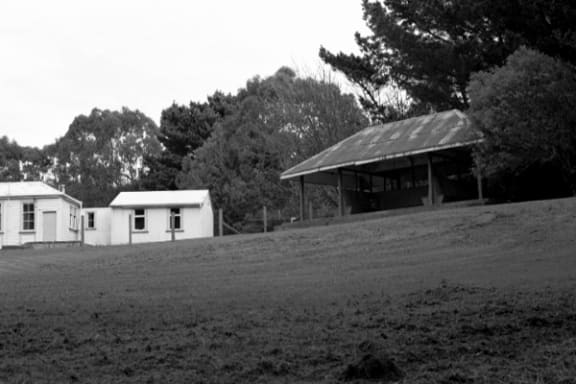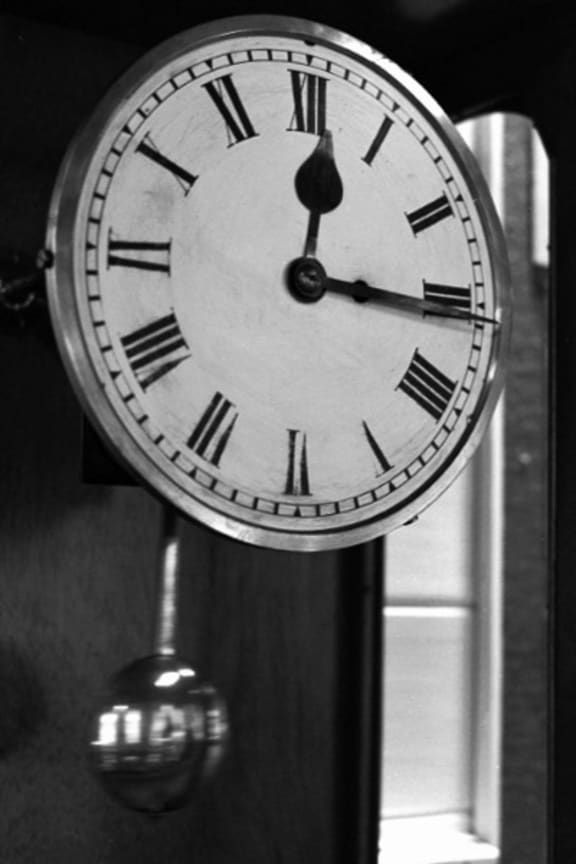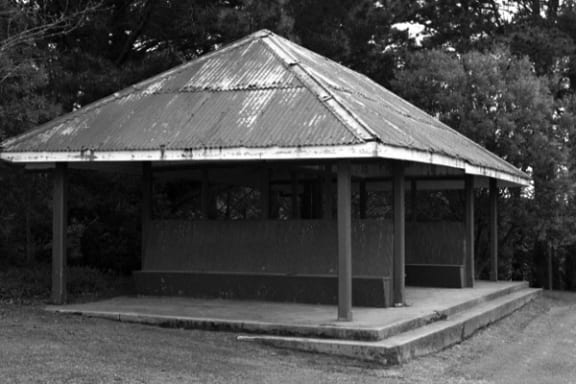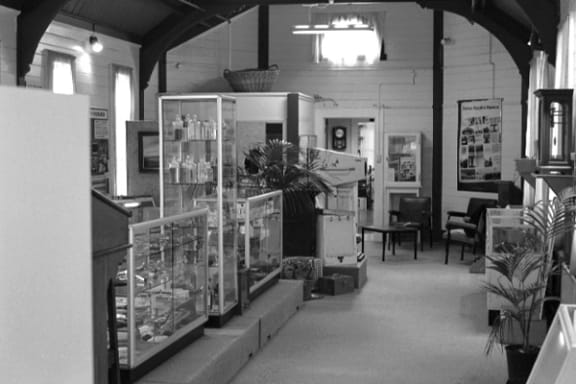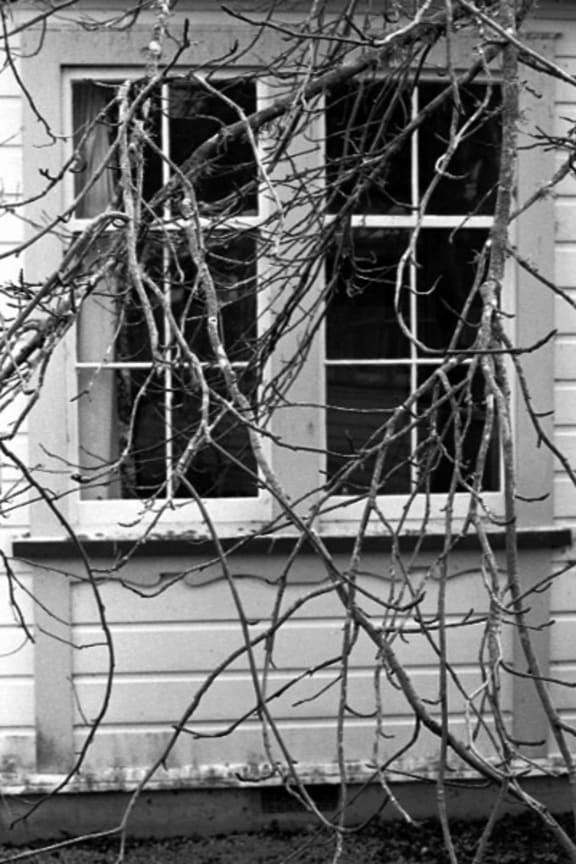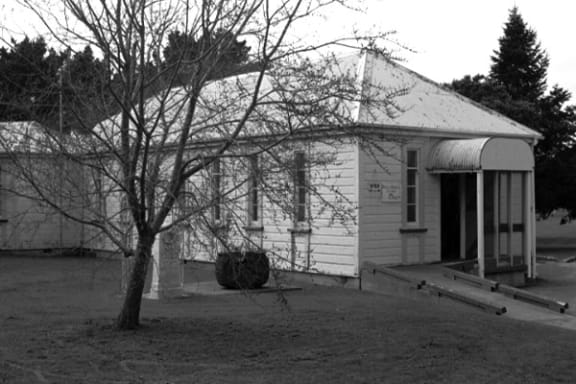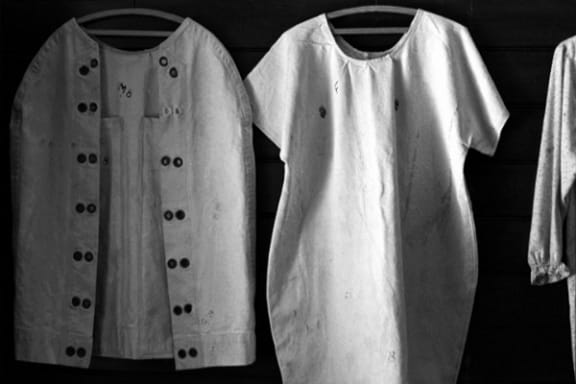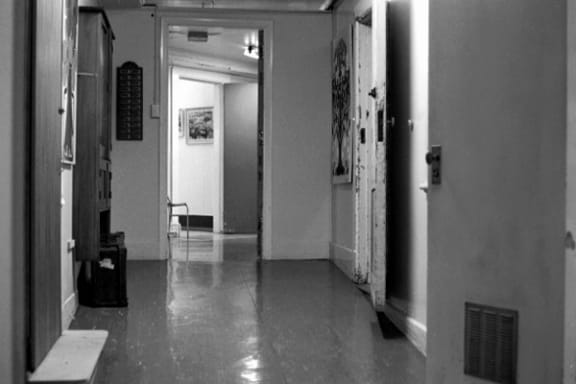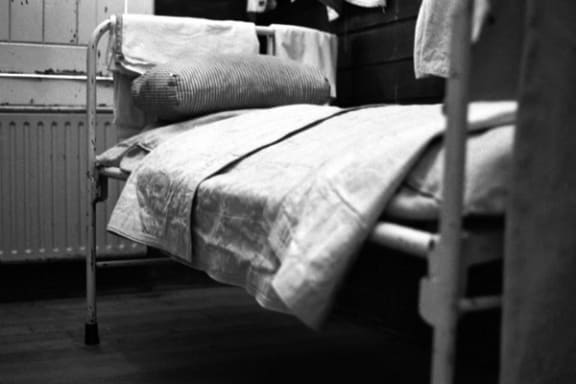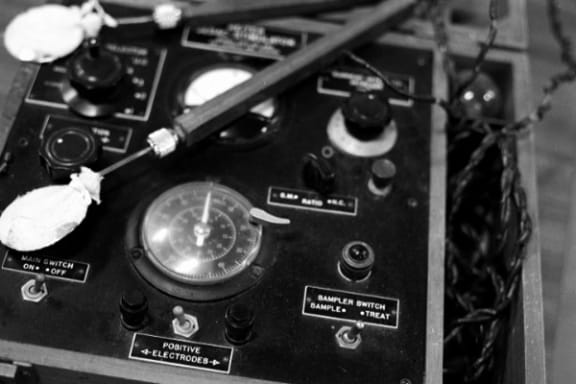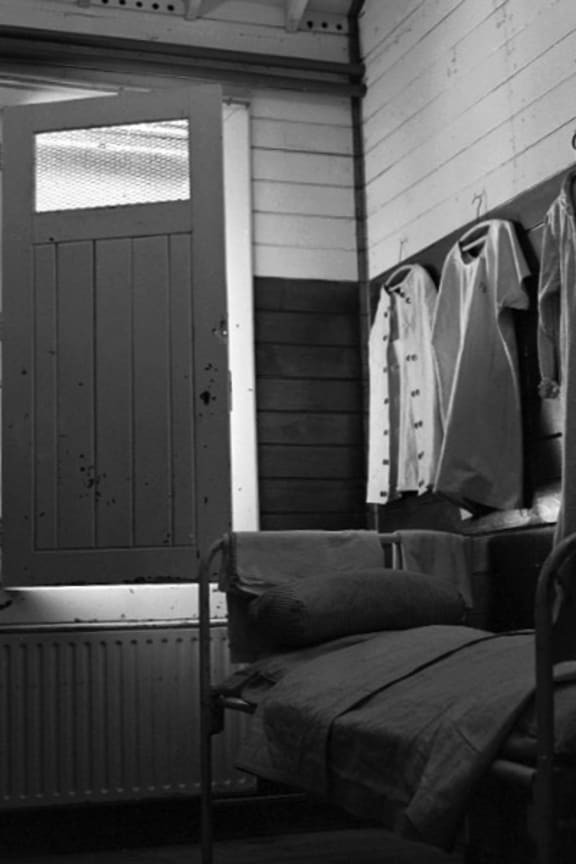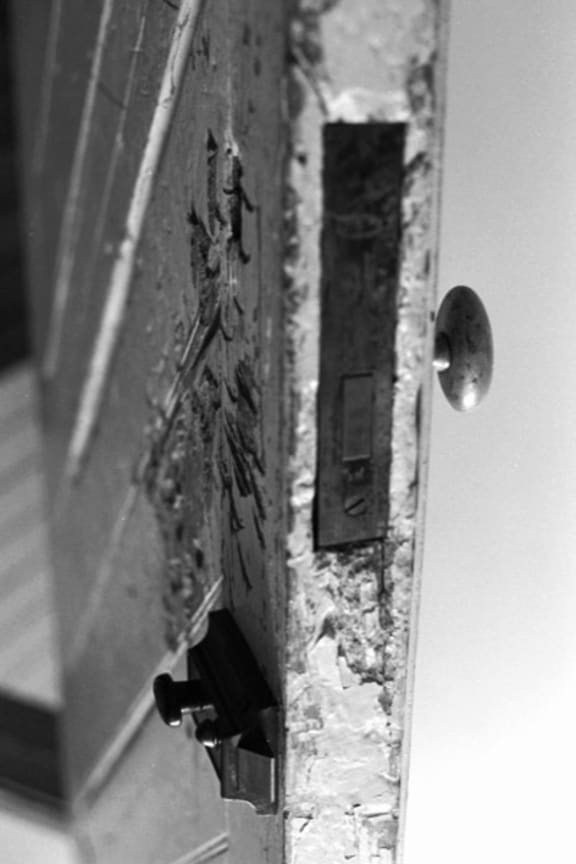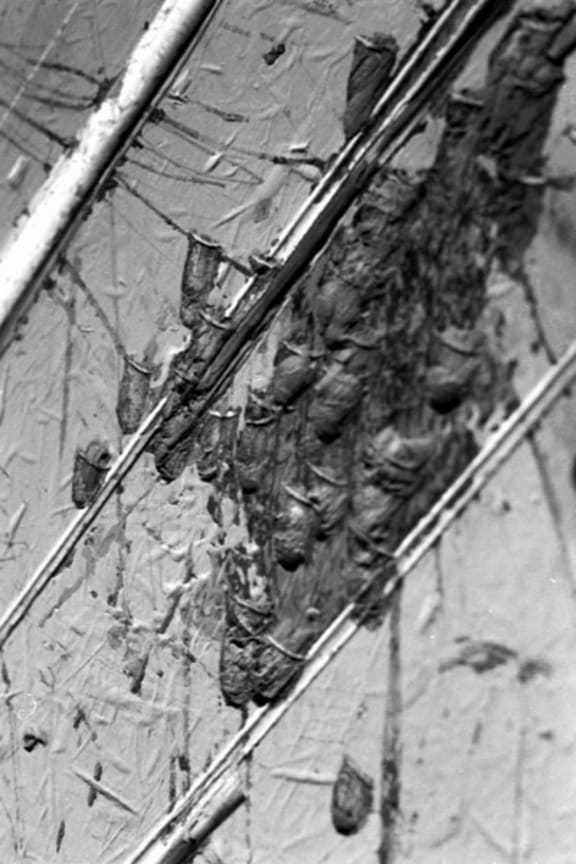Transcript
Porirua Ladies – full-length feature
00:00 Former nurses Ngaere and Rita, and Bruce –the current museum curator - begin walking around the outside of the old F Ward – now the Porirua Hospital Museum.
Ngaere: All of this was enclosed with a high fence – none of this was out in the open like that. These would be the posts.
Bruce: This here’s the courtyard of F Ward and it was surrounded by a over six-foot high wooden paling fence. We have a shade shelter that was built, and that was for - various drugs cause sunburn for patients – one of them being Paraldehyde. Paraldehyde was used as a sedative wasn’t it Ngaere?
Ngaere: Yes, yes - almost instantaneous. It was about the only thing we had was Paraldehyde - as a sedative. It wasn’t used indiscriminately. You could smell it all over the hospital, ghastly stuff – even the smell put you into sleep.
Bruce: There was several of these shade houses built around Porirua, but this is the only one that still stands.
Ngaere: It was never covered in, it was always just like that.
Bruce: Open.
Rita: And people use to come out and sit there, and it was a nice shelter. It’s been left to rot of course like a lot of the other things. But it was a great benefit to let people come out for the day, or part of the day, from the closed wards and closed rooms and so-on. And with nursing staff around they could walk around.
Ngaere: You were supposed to walk the fence all the time – take a patient or two and exercise them as well. A lot of them wouldn’t walk on their own, they would just sit.
Rita: But they got outside and they could talk to other people and walk around.
Walking
Ngaere: Up this end, there were people there that were “workers”. They used to help, they got paid a little bit of money by the government a week which bought their cigarettes and they were a bit independent. They would help in the ward, they would put the laundry out and polish the floors and do odd jobs that they were capable of doing.
Rita: What about the kitchen?
Ngaere: No, they didn’t have a kitchen here, they had a place to have [their meals]. The meals came from the main [kitchen]. But the patients here who helped slept along here. We all use to say – that was the worker’s area. They had their own rooms and they helped in the ward because there were only five staff with a hundred-and-thirty-odd people. We could never have managed without their help as far as domestic work was concerned and they were paid a little bit of money that bought their cigarettes – but cigarettes never lasted very long, and everyone would dish out smokes to them. You could get a lot of things done, they helped tremendously, if you took your packet of cigarettes out and took one out: “Would you like to go and do so-and-so”.
Rita: It was done (laughs).
Ngaere: It was barter. Of course that was all unofficial.
Rita: I’m trying to think of a woman who came out of one of the closed wards and wandered away a little bit. I persuaded her to come back in, saying the placatory things you do say: “I hope you’ve enjoyed your walk, and now it’s time to come back in and do so-and-so … We have to make sure we know where you are – we’re here to care for you”. And she said to me, “Don’t worry about me nurse – I have a rich inner life”. I just burst into tears … Don’t worry about me nurse, I have a rich inner life - I know what I’m doing.
Ngaere: She probably did too.
Rita: They taught you more lessons than the text books, and you began to see people as human beings.
Ngaere: You could laugh as often as you could cry, it was a great mixture.
Rita: A great mixture, and sometimes they broke your heart because they’d come out with something and you’d think: I never knew that about that person. What a difference it would have made if I’d known – or we’d known. But by and large they knew who they could talk to, and what they could talk about, and who would listen, and would just say “Oh, come on cut it out Betty-Anne” (laughs).
Ngaere points to the courtyard.
Ngaere: But you imagine a hundred people on this court, all in navy blue denim frocks with a red and white stripe – tiny little narrow stripe. They were all in the same thing because they were hospital garments and you couldn’t have them in their private clothes – because how would they be laundered? But the other was hospital garment, and it went in the bag to the laundry. No trouble, you could change it as many times a day as you liked… Plenty of it, there was plenty linen, plenty of bed linen, plenty of blankets. There was no shortage of anything for their physical comfort or care – comfort is not quite the word.
Ngaere: However, here they’d be lying on the ground, and you’d see all these blue humps. Call out “Lunchtime Ladies”. Every hump would move, almost run, you’d think they were starved to death, they’d want to get there first.
06:47 Meg, a former patient, reads her poem “What Dreams May Come”
Morning arrives with a shock
and the sleepers stir
in the long white ward
as the key turns in the lock.
My mouth drains dry of dreams.
Nurse stretches, lifts knitting
from a pool of light into her bag,
all meaning speared on those needles.
She is leaving. Her ghostly charges
surround her, asking for a light
for their morning cigarettes.
She calls them 'ladies'
with a touch of irony, and sighs.
And the ghostly ladies sigh
and fidget down corridors
long as nuns' prayers.
In the dining room, bewildered
at formica tables amongst tea-cup clatter
they watch while bread-and butter knives
are counted and handed out.
From the window I see a hedge
between hospital grounds and cemetery.
A fallen jam jar spills its dead
gladioli’s on a grave.
08:00 Ngaere, Rita, and Bruce continue walking around the outside of F Ward.
Ngaere: You tend to forget a lot. Good grief, normally that [plant] would never have grown, it would have been pulled out by the patients. You couldn’t grow anything in pots around there. But y’know what, they were our friends as well as - when they were well y’know.
Ngaere: Y’see, this used to look like that. It didn’t look as crummy, and of course the shelter had a painted roof … so it didn’t always look crummy.
Rita: Well where do we go from here?
Ngaere: Back to the tea-pot I hope.
Rita: Eh?
Ngaere: Back to look for the tea-pot I hope.
Rita: I want something more than the tea-pot.
Walking.
Ngaere: The trees around the hospital have always been beautiful.
Rita: This one’s dying slowly. You can see it creeping up and dying.
Ngaere: Of course the whole hospital was concrete and brick – slabs. It looked like what it was, or what you would imagine it to be.
A car passes.
Ngaere: A lot of these people couldn’t even dress or bath themselves, they went with the mob for meals otherwise they wouldn’t have known where to go.
Bruce: In the early days you would have had all of the Alzheimers, Parkinsons, Epileptics.
Ngaere: Yes, all mixed up… the Manic’s…And that room (pointing to F Ward), people that were in a manic phase - they would bang and bang and call out, you couldn’t have even a bed in there.
Rita: You had people who just had mattresses on the floor, they couldn’t have beds because they wouldn’t use them. They knew why they were there. I remember a patient once, when I had to go in and give an injection, and I said to her “Ellen, it’s Nurse McEwan - I’m coming in” and she said “Don’t you come in or I’ll give you a bloody good hiding”. I said “ok., stay there, just keep quiet for a while, I’ll come back later”. You could have that sort of dialogue, or you’d say “I’ve got to come in and I’m bringing in two people to help me with you because you’ve got to have this injection”. Deep sigh, and she’d roll over and … out.
Ngaere: And sometimes you’d have to bring the patient to the door with you, and somebody would be on the door to shut it otherwise you could never get away. It was sad but it was necessary.
Rita: It was sad but it had so much humanity. I don’t mean in terms of wonderful humanity that we spread around, but there was so much humanness in the people we were caring for and in the staff themselves who had a monumental job to care for people – to be caring. But also to know when to control situations, and how to control them so that everybody didn’t get upset.
Ngaere: They all belonged to somebody. Everyone that was in here belonged to somebody, and we were looking after them for them. And a lot of us thought of it that way, y’know they’ve got nobody else but us at the moment.
A car passes, Ngaere points to the door to F Ward.
Ngaere: That door there, had a great big wire window in it – and that was open all the time. The air went through there and it was like as cold-as-charity, everyone stayed in bed. But that is where the fresh air came in because you only had little windows.
Bruce: Ok, we’ll go in.
12:50 Ngaere, Rita, and Bruce enter into F Ward.
Ngaere: So the door was always here, but it wasn’t like that – you’d have had that wire frame in it – only at the top. It didn’t have all the windows around the outside either so the air blew in here like a gale, especially in the Southerly. But we didn’t mind that because they’d stay in bed. A lot of them wouldn’t get out of bed in the cold like that, but a lot of them would and it was not very good. I can’t see how else it could have been done – at that time.
Walking in the dormitory.
Ngaere: The beds would be down both sides facing out and sometimes we had to have two beds in the middle as well. Just ordinary beds, but there were no curtains, no blinds, you couldn’t have those – people would swing on them. These people were grossly psychotic, most of these in here. And it was more custodial care perhaps, and we cared about these people. We’d look in perhaps every quarter-of-an-hour just to make sure everything was all right. If there was a noise you’d come in smartly. I think on-the-whole, these people were very well cared for. You have the odd one here and there, and you have the odd staff that isn’t as tolerant as the next one, but that’s human nature. But there was no tolerance of cruelty anywhere between patients, staff or anything else. Never a tolerance by the authorities, which was great.
Ngaere: We were very fond of a lot of them. There was one little lady, didn’t matter if I came when they were all out on the court or all inside, she could spot me coming in onto the court, and she’d coming running up and just put her forehead on my chest – I think my chest was as low as anybody else’s – she was only little. And she’d just put her head on my chest for two or three minute’s and then away she’d go because she’d said hello … and I always use to call her ‘Mummy’ – she loved it. But those sort of things were just sort-of by-the-way.
15:53 Meg reads “Woman in Ward 10”
I see you lingering still
at the crossroads, poor martyr.
You have been so often wrong,
you'll never move again with resolution,
each blunder bringing a further injection.
You are nailed to the bed,
crucifix slipping from slackened hand,
big stubborn body thickly sleeping.
Two days ago, as ill as you,
I kissed the ring the Pope had given you
and helped deliver your immaculate child
into a hospital towel.
We hid Him on a pile of linen -
Get back on your feet, for God's sake.
I prefer you awake and mad
with staring eyes, relating stories
that are neither truth nor lies,
but which serve to pass the day
here, at the crossroads,
the corridors where we women wait.
17:00 Bruce and Ngaere look at an old map of Porirua Mental Hospital.
Ngaere: Yes, it’s hard to visualise how big the building was, and how far you had to go to get anywhere: corridors, corridors, slopes what-have-you… and taking trolleys down to the main kitchen to load them up and coming back, going down the slope…
Bruce: There was even a coal shed for the boilers.
Ngaere: Where are the kitchens from here? Well you see they’d want that because they had coal ranges for all the cooking in those days. It was all cooked by coal, the stoves would have been 6 feet wide – great long fiery things they were, they use to almost get red hot at times. And they had these great big iron boilers for the cooking and you’d go down for the meal. Hopefully they’d lift it off for you. Sometimes they sent it up in the boiler that they cooked it in, otherwise they’d tip it into a tin thing which strained a lot of it. Yes, unbelievable.
Ngaere: Is that locked Bruce?
18:58 Bruce brings out a book of old patient records
Bruce: This particular person came-in in 1911 and he died in 1912, and he died of Epilepsy.
Ngaere: Oh really… The writing is absolutely beautiful and it’s in all the books – pen and ink.
Bruce: This guy came-in in 1911 and he had “dramatic insanity” and he was discharged in February 1912.
Ngaere: Must have been welcomed home… The terminology in a lot of these is very interesting – they wouldn’t use it in this day-and-age, but it is still very interesting.
Bruce: This particular person came-in in December 1911, he had “senile dementure”, “hopeless”, and he died in January 1913.
Ngaere: A lot of these people, their mental condition, took them physically down very quickly because they were over stimulated and they’d wear themselves out – these older ones. There was nothing you could do to quieten them in those days – we had no medication. They would wear themselves out, and that would cause an early death in a lot of cases.
Ngaere: All these books are interesting because there was no medication. Half the time people couldn’t even have visitors.
Bruce: Well the relatives would have seen the patient in the state that they were in… you couldn’t really let them.
21:38 Meg reads “Glimpses into Porirua Mental Hospital”
Dirty old Rauta, and its red carpet and vaulted ceiling,
and little white beds, heaps of them,
and the strangest people, much given to burping,
and striding away with a purpose
up the red carpet to the end of the ward,
then back again to the huge fire-place. They didn’t look ill.
On the nurse's belt are some large keys
which unlock the thick doors and the giant fire-screen.
Rattling keys make this a prison hospital.
I know, in a dull way, that we, the totally dispossessed,
will not leave this extraordinary place.
A little nurse sweeps and rolls up
the long red carpet, then mops under
the little white beds. She is sole nurse and char-lady.
In the bed opposite is a lady with one fierce eye, a stroke
having paralyzed half her face. She’s a retired teacher
and talks to me about poetry. I soften a little.
23:10 Ngaere, standing in the main dormitory, describes the daily routine.
Ngaere: Seven o’clock the staff would come in they’d sign the book and the night staff would go off after they’d handed over to the day charge. Then all the patients would get up with the staff dressing, helping, bathing – whatever was necessary. 8 o’clock would be breakfast: They’d have to be two shifts because the staff would have to go down to the nurses home for their breakfast – first lot at 8, the next lot at 8:30. So you had half-an-hour to get from here down to the nurses home, have your breakfast and get back up here again. In the meantime, the beds would be stripped and fresh linen put on by whoever was here - day staff, patients helped, and they got a little allowance… we could probably have never managed without their help.
Ngaere: The rest of the day all these people would be bathed as necessary, dressed. There was no medication as-such to give out like there is now. They would go out into the courtyard if it was fine. If it wasn’t, they’d be down in the dayroom and the staff who were looking after the patients would take them down there. And you’d spend the day there doing whatever you possibly could. A lot of the patients couldn’t read, they couldn’t sew – you couldn’t give them needles and scissors, you couldn’t give them knitting needles. It was very difficult trying to entertain these people - a lot of them didn’t want to be entertained anyway. They just wanted to sit – y’know the old story “sometimes I sits and thinks, and sometimes I just sits”. And that’s how it was.
Ngaere: The staff would be on from 7 until 8 o’clock at night. Next day would be 7 until 5 o’clock at night. And the rules all said that on the third day you should be off duty – but your chances were pretty poor. You’d be called on for an overtime day, and then you’d start back on your normal routine: 7 till 8, 7 till 5, day off. You’d look at the roster board to see where the matron had put you, sometimes you were lucky to stay in a ward for any length of time. There was a charge nurse and a deputy charge of the ward, but the staff from there on could be different every day - which they tried not to have that happen, but of course in a big place like this it couldn’t be helped sometimes – sickness, absenteeism. They’d have to find somebody else who probably hadn’t worked on the ward for – lord-knows how long – and didn’t know what the routine was which was hard for everybody. If you only had four there to start with and you finish up with three and one that doesn’t know the routine – it’s almost a menace. However, we got by.
Ngaere: Night-duty, you came on at 8 o’clock at night – you had to be there by 7:40 to do the rounds and check everything. You didn’t go off until 7 in the morning. It was a long night. You relieved each other. In some wards there was only one nurse - in some of the Villas - she didn’t get any relief.
27:30 Ngaere unlocks the Store Room door.
Ngaere: This was our Store Room, our property room. In here they had a big rack that ran from there over to there and of course over the years, clothing had been left behind – like coats and frocks, and things were hanging on there. There was cases, pigeon-holes with all these things in around the room. But we use to bring our morning and afternoon-tea in here in the winter time. We’d get a suitcase or box or something and we’d get in it, under all these coats because it was the only place that it was warm. There was no central heating. Y’know we had our morning and afternoon-tea among the coats – some of them had been there since 1900 I think by the smell of them.
Bruce: They probably were from 1910 - most of the patients came in 1910 to this ward.
Ngaere: That’s right.
Bruce: We have a variety of bits and pieces in this room …
Ngaere: What happened to my night-box?
Bruce: Oh, it’s in the other room.
Ngaere: Oh, I used to have a wooden box, something like that (pointing to a mortuary box). At night-time I use to have drugs in it, and I had a key. I used to take that with me out on the round in case I needed anything. Occasionally I’d leave it in the car, but I’d lock the car - a few times I forgot to lock the car and that would be full of drugs. I couldn’t get out there fast enough.
Bruce: 1932 was the start of treatment: that was Insulin Coma. It never came to New Zealand until about 1937.
Ngaere: That was frightening.
Bruce: And very labour intensive, but it was the start of treatment.
Ngaere: They were induced into a coma and they were held in the coma for a certain length of time, and then brought out – hopefully. It was always that little bit [touch and go]. Did you ever know of anyone that succumb to Insulin Coma treatment?
Rita: No, I don’t recall anyone.
Ngaere: But we were always afraid it might.
Rita: Well, it was new and it was a little more dangerous than some of the other things perhaps we’d been using. But not necessarily so, but we had to be very careful with it because it was a new thing and so we had to treat it with respect. And it did help a lot of people.
Ngaere: Oh it did help a lot.
Rita: Suddenly a whole lot things were happening.
Ngaere: It was like when they first started E.C.T.
Rita: And Prefrontal Leucotomy – people were trying all sorts of things which were working or not working… They severe the frontal fibres and for some people it was almost relief. It was a recovery of sorts. People went on to live, I wouldn’t say normal lives, but able to function on a slightly higher…
Ngaere: But if they’d never tried these things this would never have come to this stage. It’s like the medication – ok the medication is marvellous but I think some of them are zombies.
Rita: It suddenly happened all of a sudden that there were conferences of international people – not just psychiatrists – but people concerned with mental health and well-being. And very famous names from England and America, Canada and Australia and New Zealand suddenly got together and things began to happen. There was much more of a medical model – a much more humane model so that you could have access to patients because of the affect of these drugs and so on, who hadn’t been able to communicate so well before – suddenly they could. So it had to go on didn’t it, and people were saying “oh its experimental”. Well, what isn’t experimental.
Ngaere: Well, if they’d never experimented we would have been back just as we were then… people out in canvas gowns walking around the court.
Rita: Hundreds of people benefited.
Ngaere: I can remember Dr. Medlicott telling me that he was planning on giving “treatment” to people – this was when I was down at Rauta, when I was staff nurse down there - and what he was going to do. I thought “oh my goodness”, I think I better leave now. The thought of it – of what he was going to do in the hope that these people would recover.
Rita: Well if he hadn’t had that hope, if he hadn’t been that sort of man it wouldn’t have happened.
Ngaere: And when he was getting very close to it he said “I want to talk to you about it” – to the two of us and he explained what our part would be in the treatment of these two people that he was going to do. Anyhow after he’d gone, we both looked at each other and said “better have a darn good sleep tonight – we mightn’t sleep again”.
Ngaere: Anyhow, the next day when we came to work we were all very toey because this was new altogether. He was going to put some electrodes on [to the patients head] and they were going to go off into a seizure – come out of again we hoped. However, it all went well. The whole thing went well and the patient, two days later, talked to us as if she’d been there all her life – quiet sensibly. She went home in a week.
Ngaere: But she was a funny little thing. She was very plump and she hardly ever spoke at all, [and she walked oddly]. And when I saw her walking up the corridor [after treatment] I thought well if it hasn’t done anything better than that – she’s walking properly anyway. She went home in about four days – never saw her again.
Bruce: That was the success of E.C.T.
Ngaere: That was the first success of E.C.T. Her husband was absolutely over the moon, he was happy to take her home.
34:50 Meg reads “Hole in the Head”
I have sung every song I know this night,
my fourth in isolation. By morning
I am hoarse, and none hears me
but the ladies who kick the door. "You're
down for treatment and serves you right !
making a disturbance ! But now they come,
nurses who are warders, who are nurses,
with hard, frightened hands, I plead
and fight and pull my clothes off
in a corner.
Here is the doctor , nightmare
eyes bulging, master of the machine
which glides to the bed where I am held,
temples bared, teeth clamped
on a rubber gag…….. ‘How are you, Arlin?’
he says, just as the magistrate did.
There is a smell of meths, and then,
no air -- no time to breathe .... I leave them
through a hole drilled by fire in my temples,
escaping the explosion that ends all worlds.
36:10 Ngaere flicks a light switch in the corridor, just outside the Seclusion Room.
Ngaere: All of these (pointing to the light switch), when we did a round at night it was ritual… it’s really quite hilarious when I look back on it. You’d do a round with the night-charge who was taking over the ward with the day-charge who was going off. There’d be two nurses with the day nurse and two with the night one, and the senior nurse. And you’d all do a round. One would go ahead, open the door – if you could. The light would be on, and coming behind would be one to shut the door, one to turn the light off. You’d be running to catch up with each other. And you’d go every room. The one ahead would open the door, the next one would grab it ready [to close], and that would go on every night. You made sure that everyone was here that should have been, and that was alive and should’ve been. And then the next one couldn’t say “well she must have been dead when I came on”.
Ngaere moves down the corridor.
Ngaere: In here (pointing to door), there’s a toilet, but all of that along there were about fifteen toilets. And at night-time we use to have to get all the people in that dormitory up – twice a night – to go to the toilet. What you’d do, you’d come along and you’d open these doors and make sure everything was all right. And then you’d go along and turn the light on, open up, and stand aside. They’d come tearing over there, use the toilet – perhaps, or whatever. If there was any toilet paper there somebody would go back with a whole roll … And while they were coming to the toilet there’d be a nurse – perhaps if you had two nurses – changing all the beds, putting new linen on… and somebody here washing theses people. And you’d do that two or three times a night. The amount of linen that came out of this ward was unbelievable: some of it in strips and some of it as it went in.
Ngaere: But they were human beings, and you never thought of them as anything else – they belonged to somebody. You always felt that this was somebody’s mother, somebody’s wife, somebody’s child – because we had younger girls in here as well of course. They weren’t all old fuddy-duddies like they are now, a lot of young girls. They all belonged to somebody, and we always thought of that. There’s many a time when you thought of a lot of other things too, but … But you see this corridor went away down there and then out into the day room. So there were a lot of rooms… Did you have a look through there? …
39:40 Meg reflects on being committed to Porirua Mental Hospital.
Meg: I felt terrible. I felt as if everyone was ganging up against me. I suppose paranoia was part of the illness too, and so I felt completely betrayed by everyone: my doctor, my father [who] was supposed to have said something about me. Y’know people who I’d loved and admired, but I found out that they weren’t very good friends when it came to the crunch. They weren’t to be trusted – don’t trust anybody – that’s the message I got. I always feel people have another side to them, maybe they wouldn’t very often show you. I wouldn’t be as trusting now.
42:10 Ngaere points to marks on the Seclusion Room door.
Ngaere: That’s the leg of the bed when they’ve bashed the bed to bits and broken it. They’ve over the years hammered the door with the leg of the bed.
Ngaere, Rita and Bruce in the Seclusion Room.
Rita: This was the infamous straight-jacket, and that was laced across the back.
Ngaere: The arms went down on the insides. These were only used if people tore that up (pointing to the night-dress). You couldn’t put people in here and tearing that up, they use to wrap it round, not with the intention of suicide, but they’d wrap it around their wrist and cut the circulation off … or around their neck.
Ngaere: So if they once started to tear anything – sheets, night-dresses – you’d have to put them into canvas.
Rita: And this was canvas.
Ngaere: This was canvas - very warm, but it wasn’t always a stitched canvas, it wasn’t always a stitched blanket – it could be just one big canvas sheet. You’d have to take the bed out, you couldn’t have sheets. Anything that would tear up into strips you couldn’t have, because they could wrap it around and cut the circulation. So it would go from this when they first came in, which has got kapok in it, and they could tear that up. And kapok in here – with the shutter shut and the door shut – you would suffocate. So that had to go out, and whether it was torn up or not you swept everything out. Same with the mattress, if it had kapok in it – that had to go out.
Ngaere: And you’d go into canvas which has got straw in it. You’d have a straw pillow. If they tore the canvas up and the straw was on the floor it was very warm. You’d have to take the bed out as well of course. You’d look in and you wouldn’t see a soul in here and you’d have to come in and feel all around in the straw. They’d be as warm as toast, stark naked, ‘cause they wouldn’t keep a canvas gown on. You couldn’t have this because they would tear it up and the premium thing was their safety. So, they’d have the straw all over the floor but they’d be as warm as toast. I remember saying to somebody once, “Isn’t it disgusting that these people are lying under straw”. And this bloke, it was one of the doctors, “What are you going on about – a horse lies under straw and it’s as warm as toast”. And I thought how right he is.
Ngaere: These people were warm – the straw kept them warm. And all you could see was straw. And of course this [locking window] would be shut. All the staff had a key like that attached to your person. You couldn’t lock it and walk away and leave it there because you were tied to it. So that was safe as far as the glass was concerned.
Rita: It’s a marvellous old lock. It’s been there for so many years. It’s amazing isn’t it.
Ngaere: The same old lock that’s been there forever. Look at that.
Ngaere demonstrates the double locking mechanism.
Ngaere: We all had a key that would lock it once. But if you wanted a safety, some of the seniors had a check-key that you could turn it twice. And it was only a check-key that would open it. I use to hate check-keys because if there was a fire and you were the only one [on], who has the other key? You’re supposed to know of course.
Bruce: You can actually hear the lock: one, two.
Ngaere: It’s not every lock that would do that.
Bruce: And you had a male key and there was a female key. The male key opened the male side.
Ngaere: Well this is one of the keys … that shaped key would open both sides.
Bruce: This was a grand master this one. And then you had a master key that the senior staff…
Ngaere: I had a master key when I was night supervisor, and that would open male and female doors.
Bruce: The grand master was held by the medical superintendent, the administrator…
Ngaere: And the senior doctor who was on-call at night.
Bruce: And the master key would have been held by doctors, the matron and senior staff.
Ngaere: I always had a master key on night duty because I had to get into everywhere if I could, because I was going around all the wards and I had to have access. So I had a master key, and I had it on my key ring for years.
Ngaere moves over to the doorway of the Seclusion Room where there is a small observation hole.
Ngaere: That was the observation glass. Somebody ripped it off the wall and somebody put it back like that – but there was no glass in it, I don’t know if there was any glass in that.
Bruce: Yes there was.
Ngaere: But somebody’s attacked it with a spoon or something because they wouldn’t have had any knives or anything in here, so how they managed to … You should see the four corners of the room if you look into it properly. Can you see? You could look in there without opening the door every time you came [past]. Staff, when you walked past when there was someone in here in seclusion, any staff walking past would just look in and make sure they were all right because you’d leave the light on. But you could just look in and see, even if they were down there. But that [observation hole] when it was repaired wasn’t repaired as it should have been, it was near enough because we had medication by that time.
Ngaere: But it was cosy little room.
Ngaere leaves the Seclusion Room and moves into the corridor.
Ngaere: Well its time we had a cup-of-tea… Thank you. It’s time we had a cup-of-tea.
49:45 Meg talks about E.C.T. treatment
Meg: But one thing I could never understand was what governed the amount of current that they put through your head. They didn’t explain that, nobody had anything explained to them. I had a nurse holding my hand if ever I was going to have “treatment”, she would come and hold my hand. Not always the same nurse, but someone who I felt I trusted and that made it a lot better for me if she was there I was able to overcome that feeling that they were against me, that they were trying to kill me. But in the old days, back in the 50s, they use to do it to large numbers of people – y’know maybe 20 people or something. They use to have them spread on the beds and you use to have to walk past all these comatose people to have your “treatment” – there they all were, just flaked out.
Meg: You just knew you couldn’t fight them. You didn’t have any defences against them at all – the doctors, the nurses – you just knew you had to submit to it. But that’s not what they do now. I don’t think they’d dare to do that now – not the way they use to. I wouldn’t like to be in that situation again. And the people who I learnt to distrust then I still distrust – even today, and I always will. Because we meet them socially quite a lot and if I can avoid them I will. I don’t like them very much.
52:10 Bruce and Ngaere have a cup-of-tea while looking through the Official Visitors Book.
Bruce: I’ll get you to look at this book here.
Ngaere: Do you realise it must be darn-near-seventy-years since I looked at these books.
Bruce: This is the “Official Visitors book of Porirua Hospital”. Official Visitors were the safe guard put in place by government for the patients and the staff. Also written in these books were the reports from the inspectors. The date here is the 28 November 1887.
Ngaere: That’s actually when this place was opened – 1887.
Bruce: And it just says “Dean MacGregor – inspector: On the January 31st 1888, have carefully examined the asylum and the inmates and found everything satisfactory. A lot of the entries are “visited asylum, found all well” and that’s all that’s stated, and this comes up quite often. “Visited asylum, saw patients at tea, heard no complaints”.
Ngaere: Have you come to Annie McVicar?
Bruce: No.
Ngaere: Somebody shut her in a room here once, they thought she was a patient. Took her bag off her to. She was about as tall as me, as short as me – whichever way you like. She use to wear a hat with a rim. She had a funny little coat that had a bit of rabbit fur around the top – year in and year out, every time she came. She had this little bag, and she use to walk round and somebody thought that she was a patient … she was trying to get out the door and so they put her in a room. Oh, she was wild.
Bruce: She writes here “On April 20th visited the main building and annexes. The shortness of staff is very apparent. The charge nurses are very worried in their wards. The matrons do all they can but are also very worried. Hope that the situation improves. I have authorised the burning of patients letters.”
Ngaere: The Official Visitor use to collect their letters as well and she would sanction whether they were sent or not. She didn’t know these people very well all the same.
Bruce: I don’t know quite who signed this, I think it might be Mr Bothamley. “5th April 1950 – I visited this institution this afternoon seeing Rauta and the lower buildings. In each case, saw and spoke to many patients. I had a good look through all the wards and day-rooms but received no complaints. I then asked to see F Ward and the female section because I’d heard it was not all it might be. I found that this ward is capable of handling about 80 patients and at the moment it is accommodating about 130. I was informed that patients were arriving at the rate of 750 yearly – roughly forty-percent of which are voluntary boarders. Many of these are old people who cannot be cared for at home. I am fully aware that this whole institution is badly overcrowded – something like 300 too many patients - but want to say that this overcrowding has been going on for many years till one gets tired of being told ‘that when such-in-such a new building is complete it will be relieved’. I’ve reached the stage where I’m beginning to doubt that the surplus will ever be overtaken under present methods of administration. The sleeping ward I saw would make a wonderful page in ‘Truth’. The beds were placed hard against one another on both sides of the ward and the centre isle had no less than sixteen mattresses – shake-down beds on the floor with scarcely room for a nurse to walk. These shakedowns were so placed that the head of each bed overlapped another so that the patient had to sleep with their head on the feet of the next patient…”
Ngaere: What ward was that?
Bruce: F. “…This I considered is a lamentable state of affairs for a public institution and should be remedied forthwith.” That is quite a good slap.
Ngaere: Of course the beds were exactly as he said – there was no room to walk between the mattresses on the floor and one persons feet were at the other persons head, and there was no room to put your foot – it was terrible.
Ngaere: If you’re not bloomin’ careful I’ll have to have another cup-of-tea.
58:30 Meg talks about the reduction of her world.
Meg: And the funny thing is, is that you reduce your world to the size of the hospital – what freedoms you have. That’s the boundary, the perimeter – the ward, the hospital. And you begin to live life within that very confined circle. You stop thinking of people on the outside or what’s happening out there. And you make your plans for your life within that circle. You think if I’m going to be here another twenty years if I do this-or-that might be handy, it might give me a little bit more freedom. And in the beginning you think in terms of perhaps being there for the rest of your life. And the way to cope with that is to reduce the size of your world – make your world very little. That’s what I always did. So people found it hard if they came to see me I’d often lost interest in that world outside, I was just operating in the hospital: that was unhappy as far as they were concerned. I know how they feel, if you go and see somebody in a hospital and they don’t recognise you – that’s very awful. And I think the thing is I didn’t really recognise them because I didn’t want to think about the real world. The real world for me was just the world of the ward and my relationships within that ward with the different people there and the nursing staff. So my world just came to be little.
Meg: The kids were quite upset to come and see me. I wouldn’t know what it was that they were doing. I’d sort of stopped being a mother I think … hmm.
1:01:20 Ngaere reflects in the Seclusion Room.
Ngaere: The whole place had a very, very distinctive smell – particularly this ward. You can use your own imagination as to what it smelt like – a lot of these people were doubly-incontinent, and they use to paint the walls. Odd things, that their mental condition didn’t tell them they were on the wrong plane. Yes, this place had a smell all of its own. It’s gone now: food, faeces, urine and yet it would be one of the cleanest wards in the hospital because it was scrubbed so much, washed so much, patients were bathed so much and yet it had that terrible smell.
Ngaere: There were some things that you had to do that didn’t come under the nursing banner – but you did it. There use to be some pipes that ran through there it must be (pointing to the roof) – hot water, hot air – and of course this room was always warm – which never ever helps.
Ngaere: Another smell I can remember would be something … It has to be sharp, sharp, take your breath away when you inhale. Take your breath away when you’re giving it, let alone when they’re given it. I can’t think of anything that would even compare with it. It was like a burning smell. If somebody had been given Paraldehyde down the other end of corridor we’d smell it here, especially if it had been spat around or thrown about. But it was effective – almost instantly effective in some cases. But you only gave it in dram lots – half-a-teaspoon, a teaspoon full would be a lot of Paraldehyde. But what else? Nothing else that we knew of. It didn’t seem to have a hang over like a lot of other medications do. Y’know, if you have Chloroform you would get a bit of a hangover, but they didn’t seem to have a hangover with Paraldehyde – except the smell. You could smell somebody up the other end of the corridor that had had Paraldehyde. We should have saved a little bit for these occasions – just to let you have a sniff.
Ngaere: But you’d walk into the dining room down at the home – you’d get your pedigree smartly. They’d say “who’ve you been giving Paraldehyde to” and you’d hardly be in the door. Smell you from here. Probably somebody had sprayed you with it.
Ngaere glances around the Seclusion Room.
Ngaere: It looks terrible, and you must admit it looks terrible. But what would you have done under the same circumstances – that the patient had to be safe, had to be secure, had to be warm – wouldn’t keep clothes on. There was nothing else really that you could do. There were pipes up there – the heat – but sometimes the heat wasn’t enough, sometimes it was too much and you couldn’t breathe. But at least they were safe, and so was everybody else. And that’s what a lot of people seem to forget that everybody else was safe as well as the patient. It wasn’t easy, at times it was really tough. But I think most of us in those days accepted exactly what it was and we were mainly a very happy mob. But no, I can’t think of anything that could have been done by the authorities or us, there was many a time we’d have liked to have done something, but you couldn’t do much because of the safety of everybody. Y’know the patients were safe, they were well fed, they were warm, what more can you ask.
1:06:45 Meg’s thoughts as a patient.
Meg: I had a patient set on to me when I was in Villa 9 – which is the Women’s Refractory. After F Ward they moved it up to this Villa 9 as they called it. I’d only been there about two days and I was talking and must have annoyed the nurses for some reason and they went and got this girl called Ramari, and they got her to… they set her on to me. She pulled a great patch of hair out of my scalp. She was quite fearsome. And they just stood there, in the doorway and said “Alright, have you had enough?” And then they took her out and locked the door on me and I was just left there with this bundle of hair and a bald patch on the top of my head. They were shocking, there were some really really shocking nurses who were just there for the money and had no education at all – who had come down from TeKuiti or somewhere like that, and Porirua Hospital was paying big sums of money – relatively speaking – and so they’d get jobs there. But they didn’t care about the patients or anything.
Meg: They absolutely hated me – I don’t know why. I think I had too much to say. And this girl Ramari, she fought me, I didn’t fight back. But she was told to punish me for what I’d done. Later on I became a friend of hers, and she eventually died on the railway tracks down at Porirua railway station. So she came to an unfortunate end. So, there are certainly lovely nurses there – like the one’s that would hold my hand when I was having “treatment”, calm me down so I wouldn’t be frightened. But then there were these other ones who were a bit monstrous really. Not very nice.
Meg: So what were we talking about? Fear. Yeah, I am afraid of being locked up. To be locked up for several days is pretty awful. And you just have to go to the toilet on the floor because they don’t put anything in there for you to go to the toilet in. And yet they just leave you and leave you and leave you. So they sort of reduce you to an animal even if you weren’t beforehand. Maybe that’s part of their idea of how to deal with troublesome people. I’d broken my guitar – I think that’s why I got sent there… yeah.
Meg: But also, once you’ve been a patient, I think one of the really scary things is that you don’t have any credibility anymore. Every time I go to a specialist with some illness that specialist reads beforehand that I am on this drug and that drug, and usually just gives me hell, just dismisses everything I’m saying and is really horrible. And I know it’s because they start of with preconceived notions ‘Oh, I must be a nutcase so I’m probably going to tell lies and make things up.’ That’s quite fearful, especially sometimes it’s really important that people believe you in what you say and if you have no credibility it puts you at a terrible disadvantage. Y’know, you get so exasperated – ‘ Oh, what’s the use’. What’s the use of trying to warn people – they don’t want to hear.
Meg: So I keep very quiet, I don’t do things like going in marches and demonstrations and things like that because I’m scared I might end up with the police locking me up – that’s the last thing I want is to be put in a cell and locked in. So I just think no, that’s not for me. And when Alistair and the kids went on that, y’know the [1981] Springbok Tour, where everybody got out and demonstrated, and they were at Rintoul Street when things were getting very bad. But I didn’t go with them because I said to myself ‘what if I should get locked up, maybe I’ll go to far, maybe I’ll antagonise some policeman and he’ll drag me off’. I just can’t afford that, no matter what the cause, I’m not going to make a martyr of myself. I’ve done all that, I don’t want anymore of it. I just want to be in rooms that aren’t locked, and relationships that aren’t locked and yeah… Just, y’know coast, coast along.
1:14:00 Ngaere reflects on the changes in treatment.
Ngaere: Well of course medication made the patients more co-operative and would be a little bit more normal. A lot of them went home with medication. Prior to that there was nothing, so you had to talk fast or move fast. But the people here – they were warm, they were fed, they were bathed and they were cared for in a community here where they couldn’t have been out in a public community. They couldn’t care for themselves in any way a lot of them. So it had to be here, where else was there going to be. And I think taking everything all round – a lot of us grizzled and groaned and moaned, people groaned about it, but what else was there – where else was there.
Ngaere: There were a lot of people, and they all belonged to somebody. And I think, if anybody asked me, they should all be here still a lot of these people. They shouldn’t be out on the streets trying to look after themselves. A lot of them, it’s only care and comfort and having somebody to take notice that they were even able get where they are. But who’s looking after them? Who’s seeing they’re warm with clean clothes and a bath, something to eat. Are they sick or well? I worry about them out with no one now. I shouldn’t say no one – there is someone looking after them but not everyday.
1:16:45 Meg reflects on Porirua Hospital Museum.
Meg: The museum at Porirua Hospital is very interesting but it doesn’t really capture the feelings of helplessness and the disgrace of being there, the humiliation of being treated practically like an animal. Those things are the invisible things that I don’t suppose anybody would feel unless they’d been through it. The E.C.T. machines didn’t do anything to frighten me, I wasn’t frightened when I saw the old fashioned kind and the modern kind - it was interesting, but it doesn’t really give you a feeling of awe or fear. Maybe more the little room – Solitary – with the straight-jacket type clothing, yes I think that was getting nearer to it.
Meg: You might say the walls can speak but they don’t really – not the way its … The way it’s all set up now looks just so innocuous and you have to pinch yourself to think ‘were people locked up in here, were they really suffering the way I’d heard they’d suffered’. Y’know, they were frightened out of their wits.
Meg: They do their best though – they can’t have real people showing how they feel about being there. It just doesn’t translate so much – the fear and the people who spent years and years of their lives. Y’know maybe put in hospital when they were 14 or 15 years old and when they turn 30 they’re still there in Porirua Hospital. There’s not people like that now, but when I was there one friend of mine had been there 21 years and that was one of the really frightening things. But I don’t think the old F Ward – the museum, I don’t think it shows you really the depth of like the miseries of people who lived there, not because they don’t try – because they do, they’ve got a good museum, but I don’t think people would have that profound feeling of despair and desperation that the patients there had - humiliation.
1:21:05 Ngaere reflects.
Ngaere: Met some lovely people here – they were psychotic but they were still lovely people, and their relatives, their children. Y’know, it’s not what people think – sometimes it was worse, but mostly it was a wonderful life for all of us. No, I’d never regret any of it, and I think under the circumstances of what was known about it all and what was available for their help the hospital administration did extremely well with these people. A lot of it was not as good as it should be, and a lot of it was better. I haven’t got any shame of anything I ever did. But when people start maligning the hospital I feel very poorly about it. And when patients say “I can’t do that because I’ve been mad … somebody told me I’m mad” – it’s sad. We’re all mad at times, but y’see you could always bring your key out of your pocket and say “I can’t be I’ve got a key”. Mm.



